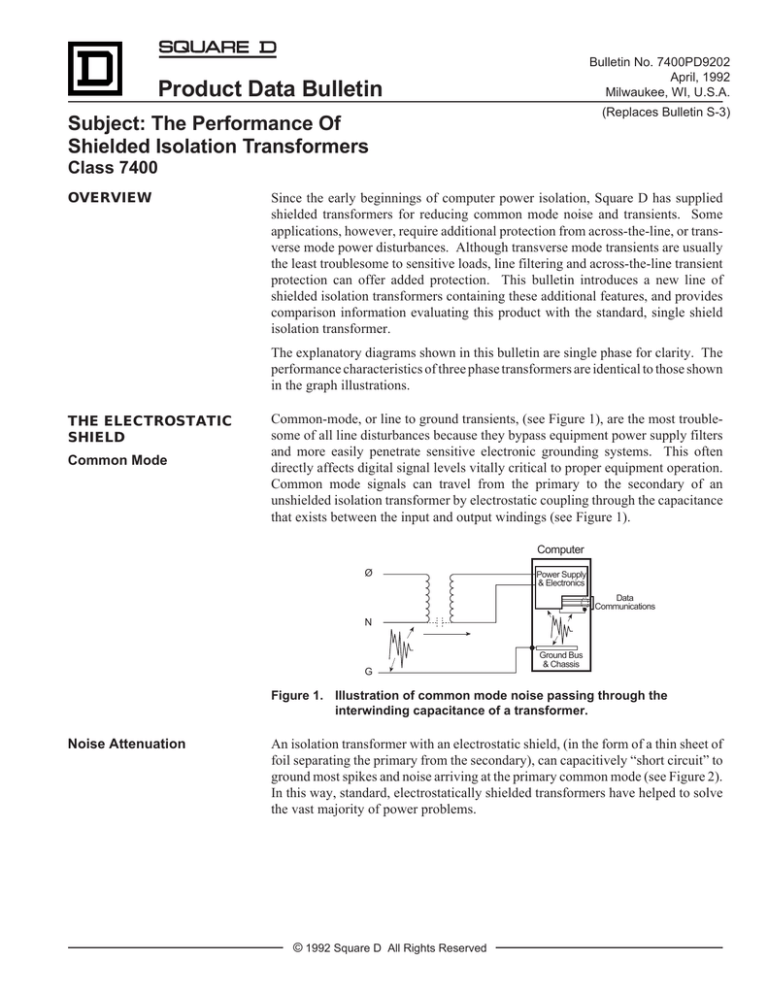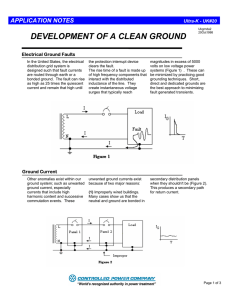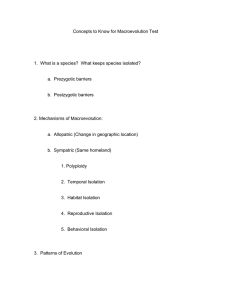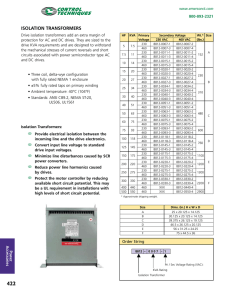
Bulletin No. 7400PD9202
April, 1992
Milwaukee, WI, U.S.A.
Product Data Bulletin
(Replaces Bulletin S-3)
Subject: The Performance Of
Shielded Isolation Transformers
Class 7400
OVERVIEW
Since the early beginnings of computer power isolation, Square D has supplied
shielded transformers for reducing common mode noise and transients. Some
applications, however, require additional protection from across-the-line, or transverse mode power disturbances. Although transverse mode transients are usually
the least troublesome to sensitive loads, line filtering and across-the-line transient
protection can offer added protection. This bulletin introduces a new line of
shielded isolation transformers containing these additional features, and provides
comparison information evaluating this product with the standard, single shield
isolation transformer.
The explanatory diagrams shown in this bulletin are single phase for clarity. The
performance characteristics of three phase transformers are identical to those shown
in the graph illustrations.
THE ELECTROSTATIC
SHIELD
Common Mode
Common-mode, or line to ground transients, (see Figure 1), are the most troublesome of all line disturbances because they bypass equipment power supply filters
and more easily penetrate sensitive electronic grounding systems. This often
directly affects digital signal levels vitally critical to proper equipment operation.
Common mode signals can travel from the primary to the secondary of an
unshielded isolation transformer by electrostatic coupling through the capacitance
that exists between the input and output windings (see Figure 1).
Computer
Ø
Power Supply
& Electronics
Data
Communications
N
G
Ground Bus
& Chassis
Figure 1. Illustration of common mode noise passing through the
interwinding capacitance of a transformer.
Noise Attenuation
An isolation transformer with an electrostatic shield, (in the form of a thin sheet of
foil separating the primary from the secondary), can capacitively “short circuit” to
ground most spikes and noise arriving at the primary common mode (see Figure 2).
In this way, standard, electrostatically shielded transformers have helped to solve
the vast majority of power problems.
© 1992 Square D All Rights Reserved
Bulletin No. 7400PD9201
April, 1992
The Performance of Shielded Isolation Transformers
Computer
Ø
Power Supply
& Electronics
Data
Communications
N
Ground Bus
& Chassis
G
Figure 2. Illustration of common mode noise attenuation values for
shielded isolation transformer.
Graph A shows an example curve of attenuation values for shielded isolation
transformers with ungrounded secondaries.
It should be noted that the vast majority of applications require that the secondary
be grounded in accordance with National Electrical Code requirements.1 It would
be reasonable to think that common mode noise could not be induced into a
grounded secondary. However, the AC resistance and inductance of even short
ground straps or conductors can present a surprisingly high impedance to high
frequency transients and noise. Since the length, size and type of grounding
conductors are installation dependent factors, it is impractical to attempt to predict
the amount of noise that can be coupled into this external ground.
Graph A
Attenuation (dB)
-50
-55
Unfiltered
Filtered
-60
1
10
100
Frequency (KHZ)
1000
Obviously, however, more efficient electrostatic shielding will decrease whatever
common mode signal is available to couple into grounded windings. The values of
attenuation shown in Graph A are shown only for illustration purposes, and are
measured using methods common to most manufacturers for evaluating shield
performance. Thus, these common-mode curves are useful in comparing shield
performance with other manufacturers, but do not show, other than in a relative way,
the performance of the shielding for normal, grounded secondary systems.
1
Page 2
NEC Article 250-5(b).
© 1992 Square D All Rights Reserved
Bulletin No. 7400PD9201
April, 1992
TRANSVERSE
MODE NOISE
The Performance of Shielded Isolation Transformers
Another type of power problem is in the form of transverse mode, or across-the-line
disturbances (see Figure 3). This is the type of noise that most people think of as line
noise, but it is least often the cause of equipment malfunction, or failure. Transverse
mode spikes and transients are not as effectively dealt with by electrostatic shielding
because they are transformed from the primary to the secondary mainly by
electromagnetic coupling rather than through capacitance between the windings.
Equipment power supplies are specifically designed to filter out transverse mode
disturbances. If proper grounding and wiring techniques are used, including
isolation of sensitive loads to dedicated branch circuits, additional protection is
usually unnecessary. However, in the event that transverse mode noise has proven
to be a problem, additional suppression and filtering must be added to the isolation
transformer.
Computer
Ø
Power Supply
& Electronics
Data
Communications
N
G
Ground Bus
& Chassis
Figure 3. Illustration of transverse-transverse attenuation through an
isolation transformer.
TRANSIENT
SUPPRESSION AND
LINE FILTERING
It is the primary purpose of a transformer to transfer power, as faithfully as possible,
from the primary to the secondary. Unfortunately, this often means coupling into
the load input transients and other troublesome deviations from the ideal, clean
power wave. A transformer couples power most efficiently at its design frequency,
(usually 60HZ). Since the transformer reactive impedance increases with frequency, the higher order harmonics and high frequency waveform spikes are greatly
attenuated with the transformer under load. This is simply because they are
dissipated across the XL component of the transformer impedance. However, under
lightly loaded conditions, the reactive drop may not provide sufficient voltage
reduction, or attenuation. Additionally, not all troublesome noise can be classified
as high frequency. Therefore, if transverse noise has shown itself to be a problem
in a given application, then clearly some remedy, other than relying on isolation
transformer impedance, may be required.
Square D isolation transformers with surge suppression and filtering can solve the
problem in two ways (see Figure 4):
1. Very fast acting metal-oxide varistor type surge suppression is provided at
the primary in order to chop very high amplitude, potentially damaging
transient levels.
2. Filtering is provided on each secondary phase to neutral leg to present a “rolloff”, or very low impedance to high frequency signals, thus providing very
large attenuation of transverse noise regardless of load on the transformer.
© 1992 Square D All Rights Reserved
Page 3
Bulletin No. 7400PD9201
April, 1992
The Performance of Shielded Isolation Transformers
Computer
FILTER
Ø
Power Supply
& Electronics
Data
Communications
N
Ground Bus
& Chassis
G
Figure 4. Illustration of transverse-transverse attenuation through a
filtered isolation transformer.
Capacitive Coupling
Graph B shows the typical amount of transverse (line-to-neutral) signal which can
be impressed into a grounded secondary as a result of common mode signal into the
primary. The capacitive coupling between the primary and secondary of a
transformer is not uniform for all turns of the coils. The unequal coupling results
in the development of a differential, or transverse signal on the secondary. Here the
benefits of the line filter on the secondary are evident when comparing unfiltered vs.
filtered isolation transformers.
Graph B
-25
Attenuation (dB)
-50
-75
-100
-125
Unfiltered
Filtered
-150
FILTERED VS.
UNFILTERED
Page 4
1
10
100
Frequency (KHZ)
1000
Finally, Graph C illustrates the typical performance of filtered vs. unfiltered
isolation transformers in an unloaded, or lightly loaded condition, in attenuating
transverse mode (across line) signals into the line-to-line (or line-to-neutral)
secondary circuit. Here the advantage of the line filter is very apparent. At 100KHZ
the filtered design produces 60 dB (1000 times) more attenuation than the unfiltered
transformer. In addition, primary surge suppression provides protection against
catastrophic impulses from the service line due to lightning and switching surges.
© 1992 Square D All Rights Reserved
Bulletin No. 7400PD9201
April, 1992
The Performance of Shielded Isolation Transformers
Graph C
0
Attenuation (dB)
-15
-30
-45
-60
Unfiltered
Filtered
-75
SUMMARY
1
10
100
Frequency (KHZ)
1000
This bulletin serves not only to explain the operation of Square D isolation
transformers, with and without filter and suppressor options, but also to illustrate the
relative complexity in the way noise and transients, of various types and frequencies, pass through an isolation transformer. Specifications containing broad
statements such as “common mode attenuation shall be 120dB minimum” should be
shown to be totally uninterpretable, especially in the case of grounded secondaries.
Such specification statements neglect defining if attenuation is common mode to
common mode, (such as in graph A), common mode to transverse mode, (such as
in graph B), or transverse mode to transverse mode, (such as in graph C). In addition,
there is a limit to how far in the frequency spectrum that an isolation transformer can
provide a given attenuation. Therefore, a specification neglecting frequency limits
is equally open to interpretation.
Standards do not exist for defining terms, test methods, or suitability to application.
Therefore, many manufacturers are using various terms describing attenuation in
different ways. Thus, competitive advantage can be gained by choosing unrealistic
test parameters, selecting advantageous portions of attenuation curves, and making
statements which are vague, or are true only in a limited scope or special circumstance. Interpretation of specifications citing attenuation values usually requires
additional investigation in order to determine which of the three types of isolation
transformers a customer is attempting to specify.
Dictating guidelines for specification interpretation is far too complex an
undertaking. Contact the appropriate product headquarters for interpretation of all
specifications requiring specific attenuation values.
The addition of Square D’s filtered isolation transformer line completes a trinity of
general types of shielded isolation transformers: (1) The single shield transformer,
(2) The single shield transformer with additional suppressors and filtering, and
© 1992 Square D All Rights Reserved
Page 5
Bulletin No. 7400PD9201
April, 1992
The Performance of Shielded Isolation Transformers
(3) the multiple, box-shielded design with suppressors and filtering. Products (1)
and (2) are available as the class 7450 product from the Square D Low Voltage
business, and product (3) is available as various Power Protection isolation products.2 The three product types represent a range of isolation protection from good
to excellent. The choice is highly dependent on many factors, a few of
which are:
• Energy, frequency and type of existing noise and/or transients
• Magnitude of reduction required
• Liability, or cost of down time
• Experience with similar installations
• Sensitivity of equipment to be protected
2
Contact Power Protection Marketing Headquarters for product information.
Printed in U.S.A.
COPYRIGHT NOTICE
©1992 Square D. All rights reserved. This document may not be copied in whole or in part, or
PLEASE NOTE:
Electrical equipment should be serviced only by qualified electrical maintenance personnel, and this
document should not be viewed as sufficient instruction for those who are not otherwise qualified to
operate, service or maintain the equipment discussed. Although reasonable care has been taken to
provide accurate and authoritative information in this document, no responsibility is assumed by
Square D for any consequences arising out of the use of this material.
Page 6
transferred to any other media, without the written permission of Square D.
© 1992 Square D All Rights Reserved





